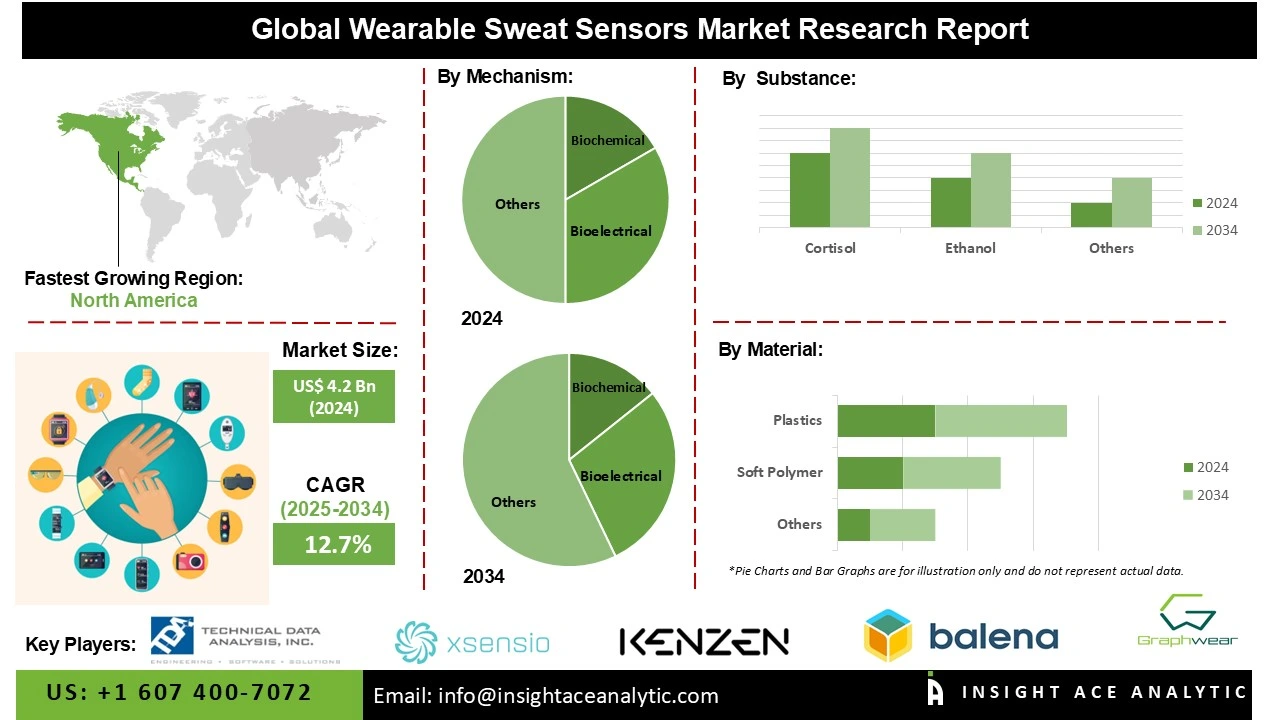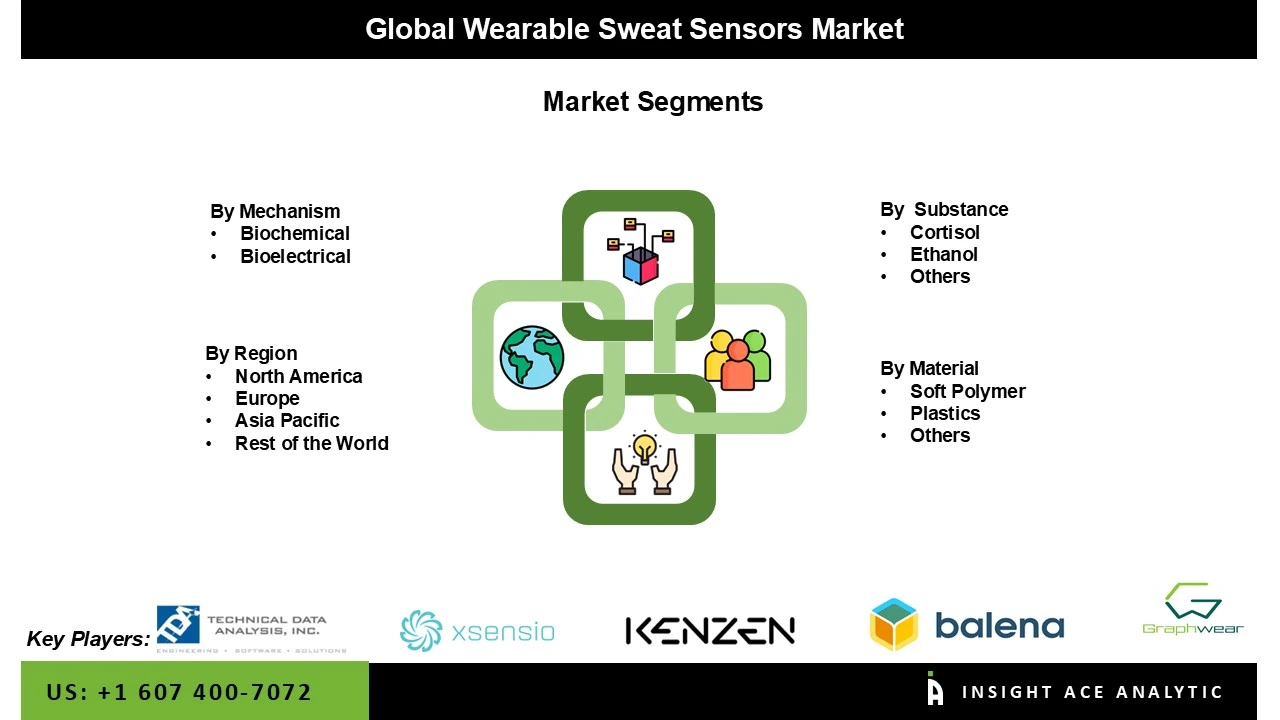Global Wearable Sweat Sensors Market Size is valued at US$ 4.2 Bn in 2024 and is predicted to reach US$ 13.4 Bn by the year 2034 at an 12.7% CAGR during the forecast period for 2025-2034.
Wearable sweat sensors are non-invasive patches or bands that analyze sweat in real-time to monitor health biomarkers like electrolytes, glucose, and hormones. They provide immediate insights into hydration, athletic performance, and medical conditions by wirelessly transmitting data to a smartphone.

The wearable sweat sensors market is experiencing growth due to the rising demand for sports and performance monitoring. Athletes and fitness enthusiasts increasingly seek real-time, non-invasive insights into hydration, electrolyte balance, and lactate levels to expand endurance, recovery, and overall performance. Unlike traditional monitoring techniques, sweat sensors delivers continuous, personalized data during physical activity, enabling proactive adjustments in training and nutrition. The growing popularity of smart wearables and connected fitness devices further boosts adoption.
The wearable sweat sensors market is strongly driven by ongoing research and development efforts in the biomedical field, which are enhancing sensor accuracy, miniaturization, and real-time monitoring capabilities. Continuous innovations are enabling sweat sensors to detect biomarkers related to hydration, glucose, electrolytes, and stress, making them highly valuable for preventive healthcare and personalized medicine. Advancements in nanomaterials, flexible electronics, and wireless communication are also boosting device efficiency and comfort. As biomedical R&D increasingly emphasizes non-invasive diagnostic tools, wearable sweat sensors are gaining momentum as a promising alternative to traditional testing methods, supporting early disease detection and improved patient monitoring.
Some of the Key Players in the Wearable Sweat Sensors Market:
· Technical Data Analysis, Inc.
· Xsensio
· Kenzen
· Gatorade
· GraphWear Technologies
· Balena
· Epicore Biosystems
· Gatorade
· Eccrine Systems
· Nix Hydration Biosensor
· Zansors
The wearable sweat sensors market is segmented by mechanism, substance, material and By Region. By mechanism, the market is segmented into biochemical, and bioelectrical. By substance, the market is segmented into cortisol, ethanol, and others. By material, the market is segmented into soft polymer, plastics, and others.
In 2024, the cortisol segment is expected to drive the wearable sweat sensors market due to the rising focus on stress tracking. Cortisol levels in sweat provide a noninvasive way to monitor stress expand market. Growing demand for real-time health insights supports adoption. Athletes, patients, and wellness users seek continuous monitoring. Advances in biosensing materials expand sensor accuracy. Healthcare providers value early stress detection for treatment. Customer’s interest in personalized health data also fuels growth.
The wearable sweat sensors market is dominated by soft polymer due to the growing use of soft polymers, which provide flexibility, comfort, and biocompatibility for continuous skin contact. Such materials allow precise tracking of electrolytes, glucose, and hydration without irritation, ensuring their suitability for extended wear. Increasing need for non-invasive, real-time healthcare monitoring in fitness, sports, and personalized healthcare applications increasingly drives adoption, positioning soft polymer-based sweat sensors as a prominent wearable technology innovation.
North America dominates the market for Wearable Sweat Sensors due to region’s increasing health and fitness consciousness in the region, with consumers increasingly embracing non-invasive technology to track hydration, electrolyte balance, and metabolic activity. Increasing incidence of diseases, like diabetes and obesity, is driving the need for continuous and personalized health monitoring solutions. Rising presence of sophisticated wearable technology players and research institutions drives innovation and commercialization of biosensors based on sweat. Growing adoption of remote patient monitoring, backed by positive healthcare reimbursement policies and telehealth growth, further adds to market growth. The population in the region with a high level of technological awareness and heavy investment in digital health fuels adoption further.
Asia Pacific is the second-largest region in the market for wearable sweat sensors. This is attributed to growing demand for non-invasive healthcare monitoring devices that offer real-time biomarker feedback on electrolytes, glucose, and hydration is driving adoption. Growing incidence of lifestyle diseases, including obesity and diabetes, is driving demand for continuous monitoring solutions outside conventional clinical environments. Growing consumer interest in fitness, sports performance, and personalized healthcare fuels adoption. Supportive government initiatives for digital health innovation and rising investments in wearable technology startups also contribute
Wearable Sweat Sensors Market by Mechanism -
· Biochemical
· Bioelectrical

Wearable Sweat Sensors Market by Substance -
· Cortisol
· Ethanol
· Others
Wearable Sweat Sensors Market by Material-
· Soft Polymer
· Plastics
· Others
Wearable Sweat Sensors Market by Region-
North America-
· The US
· Canada
Europe-
· Germany
· The UK
· France
· Italy
· Spain
· Rest of Europe
Asia-Pacific-
· China
· Japan
· India
· South Korea
· Southeast Asia
· Rest of Asia Pacific
Latin America-
· Brazil
· Argentina
· Mexico
· Rest of Latin America
Middle East & Africa-
· GCC Countries
· South Africa
· Rest of the Middle East and Africa
Chapter 1. Methodology and Scope
1.1. Research Methodology
1.2. Research Scope & Assumptions
Chapter 2. Executive Summary
Chapter 3. Global Wearable Sweat Sensors Market Snapshot
Chapter 4. Global Wearable Sweat Sensors Market Variables, Trends & Scope
4.1. Market Segmentation & Scope
4.2. Drivers
4.3. Challenges
4.4. Trends
4.5. Investment and Funding Analysis
4.6. Porter's Five Forces Analysis
4.7. Incremental Opportunity Analysis (US$ MN), 2025-2034
4.8. Global Wearable Sweat Sensors Market Penetration & Growth Prospect Mapping (US$ Mn), 2024-2034
4.9. Competitive Landscape & Market Share Analysis, By Key Player (2024)
4.10. Use/impact of AI on Wearable Sweat Sensors Market Industry Trends
Chapter 5. Wearable Sweat Sensors Market Segmentation 1: By Mechanism, Estimates & Trend Analysis
5.1. Market Share by Mechanism, 2024 & 2034
5.2. Market Size (Value (US$ Mn) & Forecasts and Trend Analyses, 2021 to 2034 for the following Mechanism:
5.2.1. Biochemical
5.2.2. Bioelectrical
Chapter 6. Wearable Sweat Sensors Market Segmentation 2: By Substance, Estimates & Trend Analysis
6.1. Market Share by Substance, 2024 & 2034
6.2. Market Size (Value (US$ Mn) & Forecasts and Trend Analyses, 2021 to 2034 for the following Substance:
6.2.1. Cortisol
6.2.2. Ethanol
6.2.3. Others
Chapter 7. Wearable Sweat Sensors Market Segmentation 3: By Material, Estimates & Trend Analysis
7.1. Market Share by Material, 2024 & 2034
7.2. Market Size (Value (US$ Mn) & Forecasts and Trend Analyses, 2021 to 2034 for the following Material:
7.2.1. Soft Polymer
7.2.2. Plastics
7.2.3. Others
Chapter 8. Wearable Sweat Sensors Market Segmentation 4: Regional Estimates & Trend Analysis
8.1. Global Wearable Sweat Sensors Market, Regional Snapshot 2024 & 2034
8.2. North America
8.2.1. North America Wearable Sweat Sensors Market Revenue (US$ Mn) Estimates and Forecasts by Country, 2021-2034
8.2.1.1. US
8.2.1.2. Canada
8.2.2. North America Wearable Sweat Sensors Market Revenue (US$ Mn) Estimates and Forecasts by Mechanism, 2021-2034
8.2.3. North America Wearable Sweat Sensors Market Revenue (US$ Mn) Estimates and Forecasts by Substance, 2021-2034
8.2.4. North America Wearable Sweat Sensors Market Revenue (US$ Mn) Estimates and Forecasts by Material, 2021-2034
8.3. Europe
8.3.1. Europe Wearable Sweat Sensors Market Revenue (US$ Mn) Estimates and Forecasts by Country, 2021-2034
8.3.1.1. Germany
8.3.1.2. U.K.
8.3.1.3. France
8.3.1.4. Italy
8.3.1.5. Spain
8.3.1.6. Rest of Europe
8.3.2. Europe Wearable Sweat Sensors Market Revenue (US$ Mn) Estimates and Forecasts by Mechanism, 2021-2034
8.3.3. Europe Wearable Sweat Sensors Market Revenue (US$ Mn) Estimates and Forecasts by Substance, 2021-2034
8.3.4. Europe Wearable Sweat Sensors Market Revenue (US$ Mn) Estimates and Forecasts by Material, 2021-2034
8.4. Asia Pacific
8.4.1. Asia Pacific Wearable Sweat Sensors Market Revenue (US$ Mn) Estimates and Forecasts by Country, 2021-2034
8.4.1.1. India
8.4.1.2. China
8.4.1.3. Japan
8.4.1.4. Australia
8.4.1.5. South Korea
8.4.1.6. Hong Kong
8.4.1.7. Southeast Asia
8.4.1.8. Rest of Asia Pacific
8.4.2. Asia Pacific Wearable Sweat Sensors Market Revenue (US$ Mn) Estimates and Forecasts by Mechanism, 2021-2034
8.4.3. Asia Pacific Wearable Sweat Sensors Market Revenue (US$ Mn) Estimates and Forecasts by Substance, 2021-2034
8.4.4. Asia Pacific Wearable Sweat Sensors Market Revenue (US$ Mn) Estimates and Forecasts by Material, 2021-2034
8.5. Latin America
8.5.1. Latin America Wearable Sweat Sensors Market Revenue (US$ Mn) Estimates and Forecasts by Country, 2021-2034
8.5.1.1. Brazil
8.5.1.2. Mexico
8.5.1.3. Rest of Latin America
8.5.2. Latin America Wearable Sweat Sensors Market Revenue (US$ Mn) Estimates and Forecasts by Mechanism, 2021-2034
8.5.3. Latin America Wearable Sweat Sensors Market Revenue (US$ Mn) Estimates and Forecasts by Substance, 2021-2034
8.5.4. Latin America Wearable Sweat Sensors Market Revenue (US$ Mn) Estimates and Forecasts by Material, 2021-2034
8.6. Middle East & Africa
8.6.1. Middle East & Africa Wearable Sweat Sensors Market Revenue (US$ Mn) Estimates and Forecasts by country, 2021-2034
8.6.1.1. GCC Countries
8.6.1.2. Israel
8.6.1.3. South Africa
8.6.1.4. Rest of Middle East and Africa
8.6.2. Middle East & Africa Wearable Sweat Sensors Market Revenue (US$ Mn) Estimates and Forecasts by Mechanism, 2021-2034
8.6.3. Middle East & Africa Wearable Sweat Sensors Market Revenue (US$ Mn) Estimates and Forecasts by Substance, 2021-2034
8.6.4. Middle East & Africa Wearable Sweat Sensors Market Revenue (US$ Mn) Estimates and Forecasts by Material, 2021-2034
Chapter 9. Competitive Landscape
9.1. Major Mergers and Acquisitions/Strategic Alliances
9.2. Company Profiles
9.2.1. Technical Data Analysis, Inc.
9.2.1.1. Business Overview
9.2.1.2. Key Product/Service
9.2.1.3. Financial Performance
9.2.1.4. Geographical Presence
9.2.1.5. Recent Developments with Business Strategy
9.2.2. Xsensio
9.2.3. Kenzen
9.2.4. Gatorade
9.2.5. GraphWear Technologies
9.2.6. Balena
9.2.7. Epicore Biosystems
9.2.8. Gatorade
9.2.9. Eccrine Systems
9.2.10. Nix Hydration Biosensor
9.2.11. Zansors
9.2.12. Others
Wearable Sweat Sensors Market by Mechanism -
· Biochemical
· Bioelectrical
Wearable Sweat Sensors Market by Substance -
· Cortisol
· Ethanol
· Others
Wearable Sweat Sensors Market by Material-
· Soft Polymer
· Plastics
· Others
Wearable Sweat Sensors Market by Region-
North America-
· The US
· Canada
Europe-
· Germany
· The UK
· France
· Italy
· Spain
· Rest of Europe
Asia-Pacific-
· China
· Japan
· India
· South Korea
· Southeast Asia
· Rest of Asia Pacific
Latin America-
· Brazil
· Argentina
· Mexico
· Rest of Latin America
Middle East & Africa-
· GCC Countries
· South Africa
· Rest of the Middle East and Africa